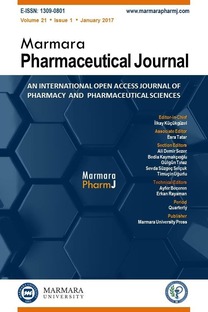Investigating the physicochemical properties of phenazopyridine hydrochloride using high-performance liquid chromatography and UV-visible spectrophotometry
___
[1] Smith DA, Allerton C, Kalgutkar AS, Waterbeemd H, Walker DK, Pharmacokinetics and Metabolism in Drug Design, Weinheim: Wiley-VCH, USA 2012.[2] Ritschel WA, Kearns GL, Handbook of Basic Pharmacokinetics - Including Clinical Applications, Washington, DC: American Pharmacists Association, USA 2004.
[3] Avdeef A, Testa B. Physicochemical Profiling in Drug Research: A Brief Survey of the State-of-the-Art of Experimental Techniques. Cell Mol Life Sci. 2002; 59 (10): 1681-1689.
[4] Alanne AL, Hyvonen H, Lahtinen M, Ylisirnio M, Turhanen P, Kolehmainen E, Peraniemi S, Vepsalainen J. Systematic Study of the Physicochemical Properties of a Homologous Series of Aminobisphosphonates. Molecules. 2012; 17 (9): 10928-10945.
[5] Box KJ, Volgyi G, Ruiz R, Comer JE, Takacs-Novak K, Bosch E, Rafols C, Roses M. Physicochemical Properties of a New Multicomponent Cosolvent System for the pK(a) Determination of Poorly Soluble Pharmaceutical Compounds. Helv Chim Acta. 2007; 90 (8): 1538-1553.
[6] Fu XC, Liang WQ, Ma WX. Relationships Between the Release of Soluble Drugs from HPMC Matrices and the Physicochemical Properties of Drugs. Pharmazie. 2003; 58(3): 221-222.
[7] Schmitt-Willich H, Brehm M, Ewers CLJ, Michl G, Muller-Fahrnow A, Petrov O, Platzek J, Raduchel B, Sulzle D. Synthesis and Physicochemical Characterization of a New Gadolinium Chelate: The liver-specific Magnetic Resonance İmaging Contrast Agent Gd-EOB-DTPA. Inorg Chem. 1999; 38 (6): 1134-1144.
[8] Ho NF, Sims SM, Vidmar TJ, Day JS, Barsuhn CL, Thomas EM, Geary TG, Thompson DP. Theoretical Perspectives on Anthelmintic Drug Discovery: Interplay of Transport Kinetics, Physicochemical Properties, and in vitro Activity of Anthelmintic Drugs. J Pharm Sci. 1994; 83 (7): 1052-1059.
[9] Lee PH, Ayyarnpalayarn SN, Carreira LA, Shalaeva M, Bhattachar S, Coselmon R, Poole S, Gifford E, Lombardo F. In silico Prediction of Ionization Constants of Drugs. Mol Pharm. 2007; 4 (4): 498-512.
[10] Ekins S, Mestres J, Testa B. In silico Pharmacology for Drug discovery: Applications to Targets and Beyond. Brit J Pharmacol. 2007; 152 (1): 21-37.
[11] Ramsay AG. Clinical Application of the Henderson-Hasselbalch Equation. Appl Ther. 1965; 7 (9): 730-736.
[12] Merck Manual, Overview of Pharmacokinetics. http://www.merckmanuals.com (accessed Sep 8, 2015).
[13] Food and Drug Administration, FDA. Available from: http://www.fda.gov (accessed Sep 8, 2015).
[14] Van de Waterbeemd H. The Fundamental Variables of the Biopharmaceutics Classification System (BCS): A Commentary. Eur J Pharm Sci. 1998; 7 (1): 1-3.
[15] Demiralay EC, Alsancak G, Ozkan SA. Determination of pKa Values of Nonsteroidal Anti-Inflammatory DrugOxicams by RP-HPLC and Their Analysis in Pharmaceutical Dosage Forms. J Sep Sci. 2009; 32: 2928-2936.
[16] Wiczling P, Kawczak P, Nasal A, Kaliszan R. Simultaneous Determination of pKa and Lipophilicity by Gradient RP HPLC. Anal Chem. 2006; 78 (1): 239-249.
[17] Celik H, Buyukaga M, Celebier M, Turkoz Acar E, Baymak MS, Gokhan-Kelekci N, Palaska E, Erdogan H. Determination of pKa Values of Some Benzoxazoline Derivatives and the Structure-Activity Relationship. J Chem Eng Data. 2013; 58 (6): 1589-1596.
[18] Dohoda D, Tsinman K, Tsinman O, Wang H, Tam KY. Spectrophotometric pKa Determination of Ionizable Pharmaceuticals: Resolution of Molecules with Weak pH-Dependent Spectral Shift. J Pharm Biomed Anal. 2015; 114: 88-96.
[19] Miyaji Y, Fujii Y, Takeyama S, Kawai Y, Kataoka M, Takahashi M, Yamashita S. Advantage of the Dissolution/Permeation System for Estimating Oral Absorption of Drug Candidates in the Drug Discovery Stage. Mol Pharm. 2016;13(5):1564-1574.
[20] Sun N, Avdeef A. Biorelevant pKa (37 C) Predicted from the 2D Structure of the Molecule and its pKa at 25 C. J Pharm Biomed Anal. 2011; 56(2): 173-182.
[21] Ahuja S, Dong MW, Handbook of Pharmaceutical Analysis by HPLC, Waltham: Elsevier, Academic Press, USA 2005.
[22] Albert A; Serjeant EP. Ionization Constants of Acids and Bases: a Laboratory Manual. Methuen London: Willey, USA 1962.
[23] OECD Guideline for the Testing of Chemicals, Partition Coefficient (n-octanol/water): Shake Flask Method, 107, 27.07.95. http://www.oecd-ilibrary.org (accessed Sep 82015).
- ISSN: 1309-0801
- Yayın Aralığı: 6
- Başlangıç: 1985
- Yayıncı: Marmara Üniversitesi
The effect of compression on solid-state properties of desloratadine and multicomponent crystal
Ahmad AINUROFIQ, Rachmat MAULUDIN, Diky MUDHAKIR, Sundani Nurono SOEWANDHI
Gopikrishna YENDURI, Srinivasu NAVULURI
Ebru TÜRKÖZ ACAR, Sinem HELVACIOĞLU, Mohammad CHAREHSAZ, Ahmet AYDIN
Development and validation of a GC-FID method for determination of cocaine in illicit drug samples
Sakine ATİLA KARACA, Duygu UĞUR YENİCELİ
Evren Homan GÖKÇE, Mustafa Sinan KAYNAK, Aysu YURDASİPER, Neslihan ÜSTÜNDAĞ-OKUR
Muhammed İhsan HAN, Hatice BEKÇİ, Ahmet CUMAOĞLU, Ş. Güniz KÜÇÜKGÜZEL
Mustafa ÇELEBİER, Engin KOÇAK, Ayşegül DOĞAN, Sacide ALTINÖZ, Nursabah Elif BAŞCI
Formulation optimization and evaluation of Cefdinir nanosuspension using 23 Factorial design
Omkar A. PATIL, Indrajeet S. PATIL, Rahul U. MANE, Dheeraj S.RANDIVE, Mangesh A. BHUTKAR, Somnath D. BHINGE
